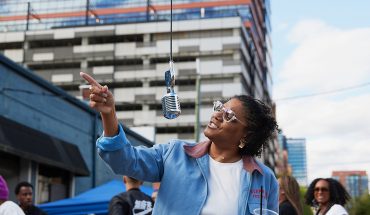Penland School of Crafts preserves a place for serious study
by Jonathan Ammons
photographs by Nick King
When you catch it on a perfect Western North Carolina day, you round the bend on the approach road to Penland School of Crafts to see a handful of buildings grazing like cattle across a distant hillside. They are of many different architectural styles across many different eras, and ideally they’ll be accented by a bit of fog lingering in the valley. The hillside oasis is Tolkien-esque. For thousands of artists and creatives from all over the world, this nearly century-old school is, indeed, a fairytale: a respite from the real world, a place to unplug. It is also a celebrated North Carolina training ground for craftspeople, a place to focus on creating rather than just producing art.
“It is the Penland School of Crafts, but the way I look at the word crafts is not so much wood whittling and pottery – although we do that kind of thing too – but it is more craft in the sense of well-made objects with a very conscious way of creating art,” says Mia Hall, newly appointed director of the school. Hall arrived in January from the University of Arkansas, where she developed a thriving furniture design and contemporary crafts program, and she has a slight Swedish accent lilting through certain syllables. She is right at home in this removed Southern retreat, because she is among leaders in the arts from all over the world.
There are courses on most major craft practices: ceramics, woodworking, weaving, jewelry making, and metalwork. There are also always creative offerings, such as bicycle building. “This semester, one of the weirder things we are offering is a custom-made jeans class,” says Hall. “They are going to make their own blue jeans.”
Creative rotation
Founded in 1923 by Lucy Morgan to teach area women skills for earning money from home, Penland started as a weaving school before expanding its horizons. Morgan hoped Penland would be a place to foster “the joy of creative occupation and a certain togetherness – working with one another in creating the good and the beautiful.”
When Bill Brown took over in the 1962, he began pushing the institution in an aggressive new direction, creating an artist residency program and expanding the amount of classes, subjects, and the lengths of those courses. By the time Jean McLaughlin became the director in 1998, Penland was beginning to gain a reputation as not just a home for American folk traditions, but also as an incubator for innovative artists to truly master the details of their craft. McLaughlin continued to grow the school and its endowment to secure it as a stalwart in the arts community, before retiring in 2017.
At Penland, students apply to take a single eight-week course as their concentration during the year; and there are smaller two-week summer sessions that focus on specific aspects of each craft. Breaking from the standard tenure model, teachers rotate out after nearly every course to make way for new instructors, new techniques, and new ideas. “We are constantly out there looking, and seeing what is going on, and if there is an artist that pops up, we bring them in,” says Hall. “If you look at the contact hours, one Penland two-week session is the same as one semester class at a college.”
Even when Penland is not in session, there are artists working year-round in studio spaces within the 57 buildings scattered across the 420- acre campus. With nearly 1,400 visitors every year, the grounds are a mountain wonderland for anyone to wander and observe. There’s also a gallery of student work open to the public every Saturday.
Make the thing’
That focused curriculum draws and even cultivates some serious artists.
“When I came to Penland, I fell in love with the place, and everything about it,” says Elizabeth Brim, who wandered into the school in the early ’80s as a printmaker, only to become one of the most well-respected blacksmiths in the nation while working as the school’s iron studio coordinator for nearly a decade. She’s come into her own at Penland. “When I told my mother that I was taking blacksmithing classes, she told me that she did not approve of that, and that it was ‘not a very ladylike thing to do.’” So Brim began wearing a string of pearls when she would work, a look she keeps up to this day – glimmers of white poking through soot and ash from the forge.
Brim is known as a master of the craft: Among her accolades are the Alex W. Bealer award from the Artist Blacksmith Association of North America, a prestigious lifetime achievement award. Brim is also known for artistically pushing the envelope. She says she has found her style in traditional blacksmithing techniques that she likes to “twist around to make something different.” Take, for example, delicate flower petals made from black iron and hammered thin; a drapsing apron with dangling straps; or her most famous piece, hand forged high-heel shoes. She even invented a technique using compressed air to inflate metal in order to make an iron pillow for her iron tiara to perch. Somehow, in all that hammering and flame, Brim creates pieces that are as rugged as they are feminine and elegant.
Metalworker Seth Gould has found inspiration and edification at Penland, too. “I will be learning for the rest of my life, whether it be a brand new technique, or learning how to forge a certain material in a certain way,” Gould says. While building spectacularly sexy tools – sleek, curvy, finessed hammers and measuring squares and calipers – pays the bills, he has a particular fascination with obscure and lost trades. Gould’s studio is filled with ornate and complex locks, cleavers, boxes, and even a duck press. They are all crafted in classic styles, but with their own particular aesthetic.
As an Artist in Residence, Gould has spent the better part of the last three years developing puzzle boxes, an old Japanese and European Renaissance tradition of handcrafted lock boxes intricately designed to require users to move through a series of steps to open the box.
“No one has made these in a very long time, so there’s certainly no how-to manual,” he laughs while showing off the skeleton of a box the size of a suitcase. Building them must be much more of a puzzle for him as unlocking them is for the rest of us. Ten locks flex with the turn of a single key, each one, and every nut, bolt, lever, hinge, and screw, having been meticulously forged, polished, and crafted by hand. “By the time this is finished, it will require 10 to 12 steps before you can even open this box,” he says. “There is no market for these, but that’s why I’m here, is to make one. Sometimes you have to make the thing before people understand that it can be made … or that it needs to be made.”
“Art is problem solving,” Hall says, explaining the remarkable 90-year staying power of this woodland school. Penland will remain because it is a place both idyllic and practical to cultivate creative thinking. “The arts are everywhere. Art is part of your entire existence. We need it as much as we need cancer research.”







